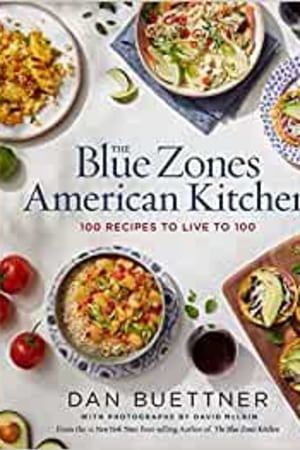Americas
- Publisher : National Geographic
- Published : 06 Dec 2022
- Pages : 304
- ISBN-10 : 1426222475
- ISBN-13 : 9781426222474
- Language : English
The Blue Zones American Kitchen: 100 Recipes to Live to 100
Best-selling Blue Zones Kitchen author Dan Buettner spent years uncovering the Blue Zones--the five places around the world where people consistently live to or past, 100--and sharing lifestyle tips and recipes gleaned from these places. Now, creating your own Blue Zone at home is easier than ever, thanks to plant-forward recipes in this inspiring book--all developed right in our own backyard.
In Blue Zones American Kitchen, Buettner uncovers the traditional roots of plant-forward cuisine in the United States. Following the acumen of heritage cooks who have passed their recipes from generation to generation, Buettner uncovers the regions and cultures that have shaped America's healthiest food landscapes, from Hmong elders living in Minnesota to Quakers in New England. Along the way, he illuminates both traditional and revolutionary ideas in vegetarian food with recipes from chefs like executive chef James Wayman, "the Gullah chef" Bill Green, and "the Cod Chef" Dave Smoke-McCluskey.
With wisdom from more than 50 food experts, chefs, and cooks around the country, Buettner's road trip across America sheds light on some of its most under-recognized plant-forward communities as Buettner shares the ingredients, recipes, and lifestyle tips that will make living to 100 both delicious and easy. And the proof is in the pudding: 49 Blue Zones Project Cities have demonstrated that eating the Blue Zones way can alleviate obesity, heart disease, diabetes, and more.
Filled with 100 tasty recipes, from Pennsylvania Dutch apple dumplings to Southern Hoppin' John, Blue Zones American Kitchen will change your diet--and your life.
Readers Top Reviews
campfiregal
Lots of great information and recipes and just a great book!!! Will buy more to gift to others.
Rosanna Mancillas
I have already tried several recipes but did run into some hiccups. Example: Making the zucchini pupusas- it says to 'serve with curtido' but doesn't tell you how to make that essential condiment. Had to look it up on another site that rhymes with frugal. I also made the collard greens recipe- but it came out tasting like nothing. I had to get a friend at work to help me fix it. But other than that, it's a good guide to eating healthy.
JimMike C.Rosanna
If you're looking for a good cookbook that provides recipes from the diverse cultures wtihin the United States, then you've come to the right place for that. This cookbook focuses on recipes and foods from indigenous, native and early American culture; African-American culture; Latin American culture, Asian American culture and regional and contemporary American cultures. But it's important to note that none of these recipes contain meat or other animal products in their ingredients. That works for me because I eat a 90% whole food, plant-based diet and having these plant-based meals in my recipe collection is a great addition. But that may not work for everybody. The book is an outgrowth of Dan Buettner's 20+ years investigating and promoting the Blue Zones cultures. For those unfamiliar with the Blue Zones, Dan, while working for National Geographic mapped out six regions in the world where people lived longer lifespans. He then looked at the data from those regions and came up with some commonalities between them that he has since promoted as being factors that can lead to a longer lifespan. Food was one of those factors although in his original writings, food or diet was not considered as major a factor as he tends to make it out to be today. Today, he promotes a plant-based diet, as I do too, but I think there are some issues with what he says about that in this book that I will discuss below. One of the issues that I have with this book is that while the cultures in this book were not vegan and the Blue Zones cultures were not vegan, except for one small subset of the Seventh Day Adventists, Dan not only ignores any animal products in these recipes but he makes statements that they are not necessary for healthy longevity. For example, on page 284, he says "In most Blue Zones....people eat fish," but then he goes on to say, "Fish is not a necessary part of a longevity diet." This flies against the advice of nutritional scientists who tell people to eat at least two servings of fish a week. And it flies against what Dan himself observed when he identified the Blue Zones. So, my question is, how can Dan, who is not a dietitian or a nutritional biochemist, make the statement that fish is not necessary for longevity? He does this with eggs as well, when he says "People in ALL the Blue Zones eat eggs about two to four times per week." But again he goes on to say, "Eggs aren't a key component for living a long life, so we don't recommend them." Again, how can he say that when people in every single Blue Zone eat eggs and they eat them several times a week? Maybe there's a reason people in every Blue Zone eats eggs half the days in a week. Isn't there a possibility that that the 10% of animal products eaten in the Blue Zones do in fact contribute something to health and longevity? Long-chain omega-3 fatty acids from fish...


